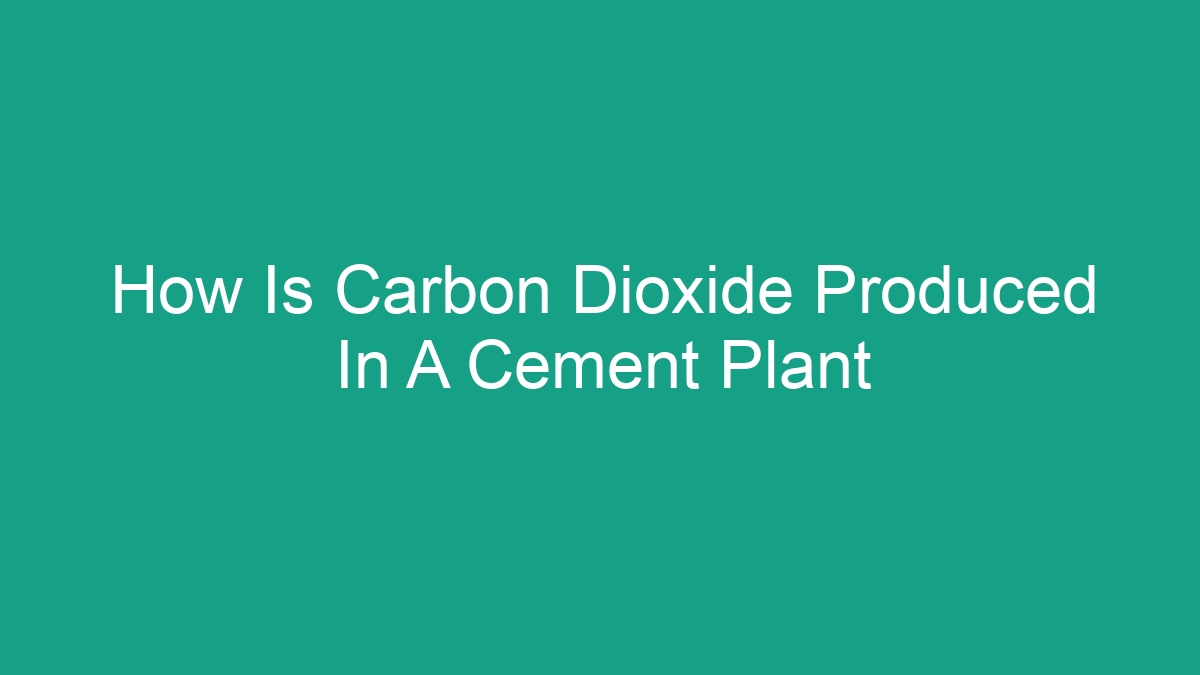
Cement production is known to be a major contributor to carbon dioxide emissions worldwide, with about 8% of global CO2 emissions originating from cement plants. Understanding how carbon dioxide is produced in a cement plant is crucial in finding ways to reduce these emissions.
1. Cement Production Process
Cement production involves the heating of raw materials to high temperatures in a kiln. The primary raw materials used in the cement manufacturing process are limestone, clay, and sand. These materials are crushed and combined in specific proportions before being fed into the kiln. The kiln’s high temperatures cause chemical reactions that transform the raw materials into clinker, the main component of cement.
During the heating process, several chemical reactions occur, leading to the production of carbon dioxide. The primary sources of CO2 emissions in cement production are fuel combustion and the calcination of limestone.
2. Fuel Combustion
Fuel combustion is a significant source of carbon dioxide emissions in cement plants. Most cement plants use fossil fuels such as coal, oil, and natural gas to provide the high temperatures required in the kiln. These fossil fuels contain carbon, which, when burned, combines with oxygen from the air to produce CO2 as a byproduct of the combustion process.
Furthermore, the process of clinker production requires a substantial amount of heat, which is typically generated by burning fossil fuels. The intense heat facilitates the chemical reactions that convert raw materials into clinker, but it also leads to the release of significant amounts of CO2.
3. Calcination of Limestone
The calcination of limestone, another critical step in cement production, also contributes to carbon dioxide emissions. Limestone, which is a key ingredient in cement manufacturing, contains calcium carbonate (CaCO3). When heated in the kiln, limestone undergoes a chemical reaction called calcination in which it is converted into calcium oxide (CaO) and carbon dioxide gas (CO2).
This process releases substantial amounts of CO2 directly to the atmosphere, adding to the overall emissions from the cement plant. The CO2 released during the calcination process accounts for a significant portion of the total carbon dioxide emissions from cement production.
4. Carbon Capture and Storage (CCS)
Given the substantial role of cement plants in global CO2 emissions, there is increasing interest in developing technologies to mitigate these emissions. One approach that has gained attention is carbon capture and storage (CCS), which involves capturing carbon dioxide emitted from industrial processes and storing it underground to prevent its release into the atmosphere.
CCS technologies are being explored as a potential solution for reducing carbon dioxide emissions from cement plants. The concept involves capturing CO2 from the flue gases generated during the cement production process and transporting it to suitable geological formations for long-term storage.
5. Use of Alternative Fuels
Another strategy for reducing carbon dioxide emissions in cement plants involves the use of alternative fuels in place of traditional fossil fuels. Alternative fuels such as biomass, waste-derived fuels, and even non-recyclable plastics can be used as a substitute for coal and other fossil fuels in the cement kiln.
When these alternative fuels are burned, they release CO2, but they also have the potential to offset emissions by diverting waste from landfills and reducing reliance on fossil fuels. Additionally, some of these alternative fuels are considered carbon-neutral, as the CO2 released during combustion is balanced by the CO2 absorbed during the growth of the biomass, making them a more sustainable option for cement production.
6. Energy Efficiency Improvements
Improving energy efficiency is another crucial aspect of reducing carbon dioxide emissions in cement plants. By implementing energy-saving technologies and process optimization measures, cement plants can reduce their overall energy consumption and, consequently, their carbon footprint.
Efforts to enhance energy efficiency can include upgrading equipment, optimizing production processes, and incorporating advanced technologies such as waste heat recovery systems. These improvements not only reduce CO2 emissions but also contribute to cost savings and a more sustainable operation of the cement plant.
7. Conclusion
Understanding how carbon dioxide is produced in a cement plant is essential for addressing the environmental impact of cement production. The combination of fuel combustion and the calcination of limestone are the primary sources of CO2 emissions in cement plants. Strategies such as carbon capture and storage, the use of alternative fuels, and energy efficiency improvements are crucial in mitigating these emissions and promoting a more sustainable cement production industry.
As the demand for cement continues to grow, it is imperative for the industry to prioritize environmental sustainability and adopt innovative technologies and practices aimed at reducing carbon dioxide emissions in cement plants.



